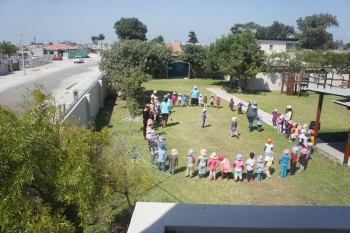By Allegra Mangione
Living in Cape Town is magical. Table Mountain is a stunning backdrop with serene beaches and quaint streets. However, every day as I leave City Bowl and make for the Northern Suburbs, I am taken aback by the contrast between westernized City Centre, and the townships, which are stark remnants of Apartheid. As we pass Langa, one of the most underserved townships, Andrew, a volunteer consultant at Etafeni Day Care Centre Trust points out, “look at all the satellite dishes.” It’s true. There are rows of one room, scrap-metal shacks and each sports a working satellite dish. Vuyo and Eliam, friends from TSiBA, who grew up in townships themselves, explain to me, “the thing visitors don’t understand is that many people living in townships are from the Eastern Cape, and have houses over there, and will spend money on cars and phones, but still live in a shack. They would rather spend their money on other things.”
 Thus, social enterprises and nonprofits in the area cannot simply combat poverty by providing goods and services to township communities without a deep understanding of the layered social dynamics that play into economic disparities between Cape Town’s many suburbs.
Thus, social enterprises and nonprofits in the area cannot simply combat poverty by providing goods and services to township communities without a deep understanding of the layered social dynamics that play into economic disparities between Cape Town’s many suburbs.
As we drive into Nyanga we pass many small, informal, businesses: beauty salons, convenience stores, furniture sold on the side of the road, braais (South African barbecues, and in Nyanga sheep meat is a favorite). Many people migrate from the Eastern Cape because Cape Town is where job opportunities are thought to be, and yet, Nyanga has an unemployment rate of 46%.
For my second co-op I am working for Etafeni, a non-profit that offers an array of programs to the Nyanga’s most vulnerable. Many of Etafeni’s programs serve children affected/infected by HIV/AIDs by providing necessary nutritional, educational and psychosocial support. Some of Etafeni’s programs, such as the Income Generation program for women living with HIV, and the Fit For Life, Fit For Work Program which offers job training and mentorship to those seeking employment, have social enterprise aspects to them, and are evolving in that direction.
As Assistant Development Manager, I am in a unique position at Etafeni. My time is split between two major projects, implementing an M&E strategy and fundraising for the organization. It has become apparent that in an organization like Etafeni, these two aspects must work together in a strategic way in order for the organization to run smoothly and achieve sustainability. Presently, Etafeni seems caught in a fundraising treadmill. With most of the funds coming from foundations and trusts, Etafeni expends many resources fundraising, and often must commit to more work and additional programs in order to secure funds. In addition, Etafeni does not have a system that facilitates clear, consistent communication between the program managers and the fundraising and finance managers. This, above all else is putting stress on the organization.
Part of my job is working on putting that system in place. This will include building the missing links between the M&E system developed by the previous co-op, and fundraising decisions. Obvious solutions to some of Etafeni’s fundraising difficulties would be bringing in more unrestricted funding from individual donors or finding internal income generation strategies. However, the reality for Etafeni, and many community-based organizations like it, is that these ideas cannot be implemented quickly. Thus, program managers must learn how to budget effectively for their programs and communicate their needs to their fundraising teams.
So how does fundraising, and M&E connect back to the post-apartheid social dynamics that I have been learning about from my peers and superiors, and observing on my own? It is very apparent that organizations that want to make a difference in the Cape Town townships must have local leadership and backing. If the leadership doesn’t understand the complicated social dynamics at play—the reasons behind the satellite dishes on Langa roofs, and Nyanga’s high unemployment rate—they will not be able to provide impactful services to the township populations.
And this is Etafeni’s strength. With most of the staff being from Nyanga, they know how to approach community development effectively. The missing piece is making sure the staff have the capacity to communicate the community’s stories through M&E in a way that will catalyze effective, precise fundraising and build strong sustainable organizations. It is humbling to be a part of this and to learn from my co workers in that regard.


